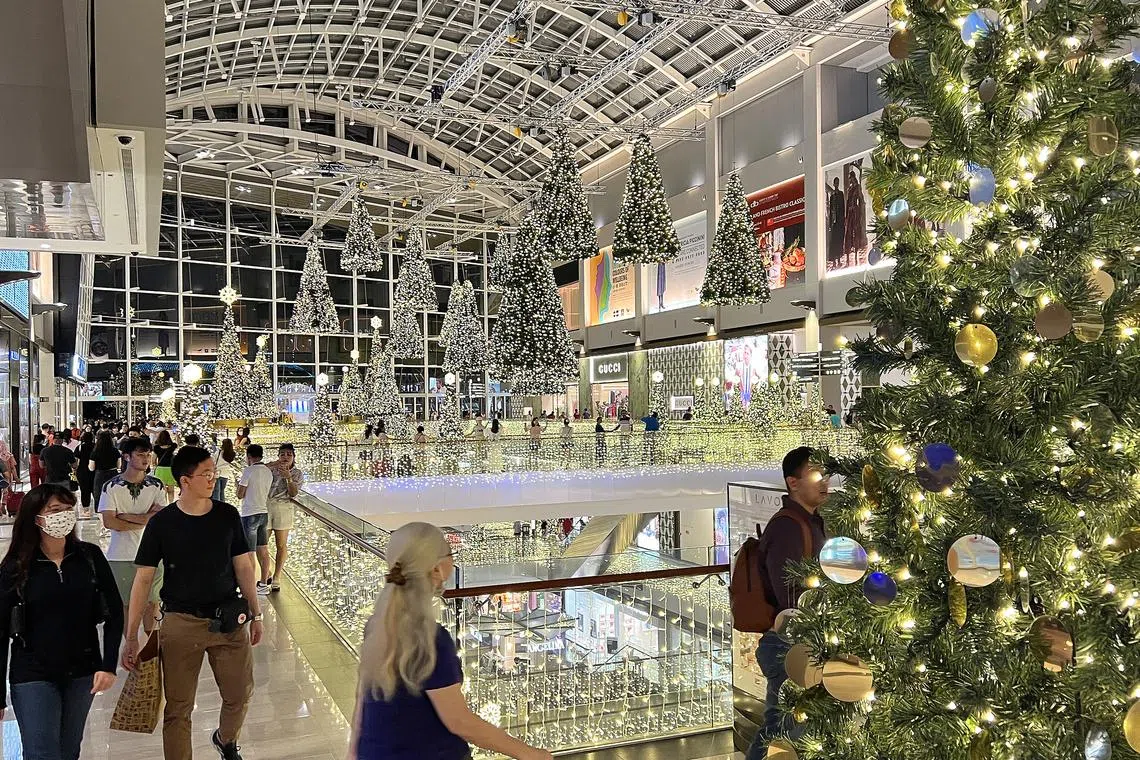Singapore retail sales pick up pace in December, rising 7.4% amid festive season
Sign up now: Get ST's newsletters delivered to your inbox

This was mainly due to higher demand for alcoholic products, including those sold in duty free shops, bags and footwear.
PHOTO: ST FILE
Follow topic:
SINGAPORE – Takings at the till climbed at a faster pace in December. However, analysts flagged a possible slowdown in growth in 2023 amid risks such as inflationary pressures, even as bright spots emerge from China’s reopening.
Retail sales rose 7.4 per cent year on year, according to figures released by the Department of Statistics on Friday, beating the 5.2 per cent growth forecast by analysts in a Bloomberg poll.
It was also better than the revised 6.5 per cent rise in November, goods and services tax (GST) hike in January.
December’s growth in retail sales comes amid the year-end festive season, a period marked by shopping sprees but also a popular time for Singaporeans to holiday abroad, which they could do much more easily in 2022.
RHB senior economist Barnabas Gan said that while retail demand ended with a bang at the end of 2022, a relative lull will likely ensue as the seasonal hype fades.
The rush by consumers to shop ahead of the GST hike will further dissipate, he said, adding that retail sales growth must also contend with a high base seen throughout 2022.
“Retail demand may also slow in tandem with easing GDP (gross domestic product) growth across Asia and Singapore, which may dissuade domestic and tourism-related expenditure, especially in the first half of 2023,” he said.
UOB senior economist Alvin Liew noted that retail sales grew by 10.5 per cent for the whole of 2022, lower than the 11.1 per cent increase seen in 2021.
While December typically sees a spike in retail sales value, the latest figure is the highest monthly record since the data was made available in 1997, he said.
Overall, the estimated total retail sales value in December was $4.7 billion, of which online sales made up an estimated 12.9 per cent, lower than the 15 per cent recorded in November when there were big online shopping events such as 11.11 sales.
“We suspect the high December sales were due to a combination of stronger demand with an element of revenge spending, higher prices due to inflation, and buying ahead of the January 2023 GST hike,” said Mr Liew.
The bank has upgraded its 2023 retail sales growth forecast to 5 per cent, from 2.3 per cent previously, due to China’s lifting of its zero-Covid policy.
“Going into 2023, one of the key downside risks to retail sales is the still-elevated inflation pressures that may increasingly curb discretionary spending of households, in addition to the GST hike from 7 per cent to 8 per cent on Jan 1,” said Mr Liew.
However, retail – as well as travel, tourism and other in-person service sectors – will benefit from the continued recovery in leisure and business air travel and China’s reopening of its borders, he added.
About 49 per cent of tourist receipts from mainland China in 2019 were from shopping, noted Mr Liew, citing Singapore Tourism Board data.
Excluding motor vehicles, retail sales in December rose by 9.5 per cent, extending the 9 per cent increase seen in November.
Overall takings rose 1.3 per cent from November, on a seasonally adjusted basis. This compares with a 3.6 per cent drop from October to November.
Year on year, retail sales grew for most categories, with food and alcohol experiencing the largest increase of 37.4 per cent, followed by apparel and footwear, which rose 23 per cent.
This was mainly due to higher demand for alcoholic products, including those sold in duty-free shops; bags and footwear.
Sales of watches and jewellery; cosmetics, toiletries and medical goods; furniture and household equipment; and at department stores grew between 11 per cent and 19.9 per cent.
However, motor vehicle sales fell 10.3 per cent due to lower certificate of entitlement quotas, while takings at petrol service stations dropped 6.8 per cent.
While retail sales climbed in December, takings of food and beverage (F&B) services saw a growth slowdown. These grew by 13.9 per cent year on year, losing speed from the 25 per cent increase in November.
Still, all industries in the sector recorded growth in sales, with food caterers seeing the largest increase of 115.8 per cent amid higher demand for event and in-flight catering. Turnover of fast-food outlets, restaurants, cafes, foodcourts and other eating places rose between 5.5 per cent and 14.6 per cent.
Total takings of F&B services edged up 0.1 per cent from November, on a seasonally adjusted basis.


